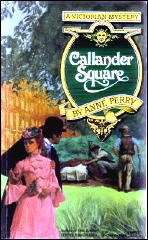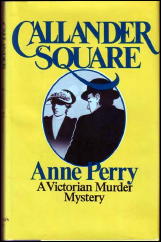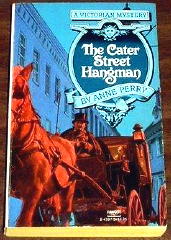Fri 14 Aug 2009
A 1001 MIDNIGHTS review: ANNE PERRY – Callander Square.
Posted by Steve under 1001 Midnights , ReviewsNo Comments
by Karol Kay Hope:
ANNE PERRY – Callander Square. St. Martin’s, hardcover, 1980. Reprint paperback: Fawcett Crest, 1981. Reprinted many times since.

Anne Perry’s books featuring London police inspector Thomas Pitt are called “Victorian mysteries.” One look at the covers of the paperback editions would lead the reader to believe they are just more of what has been called the “Gasp in the Grass” genre — the kind of stories that find the virginal heroine crawling at least once across the grassy slopes of a Victorian mansion in the moonlight.
Not so. Perry has very cleverly portrayed British Victorian society with a sharp eye for its particular brand of social deceit. She is especially skilled at making the reader realize the almost unbelievable subjugation of women in those days, and if one ever wonders why women began to rebel against social constriction at the turn of the twentieth century, these books will clear up that mystery, too.
Detective Thomas Pitt is a working-class hero in the extraordinary position of being called upon periodically to blow the cover of the English aristocracy. Being a policeman, he can exercise certain influence; if any blustering old gent attempts to order him out of the Morning Room, Pitt can threaten a search warrant.

He rarely needs to resort to such tactics, however, because he gets inside help from his charming wife, Charlotte, who stepped out of her upper-class world to marry him. She is an honest and enthusiastic woman whose family despairs of her insistence on following her own inchnations (although most of the women she grew up with admire her courage).
And she is invaluable to Pitt, since most of his cases involve his exposing the passion beneath the icy breast of the upper classes. Pitt analyzes the facts with cool logic, while Charlotte uses her family connections to pick up pertinent gossip over tea and crumpets.
In Callander Square, gardeners have inadvertently dug up the corpses of two newbom babies in the square of one of the most affluent suburbs of London. The neighborhood residents, while forced to admit the monstrosity of the deaths, simply chalk them up to the irnrnorality of some servant girl who “let herself” be molested — probably by a footman, perhaps the master of the house; gentlemen always dally with the servant girls “just for a spot of fun.”
It is too bad, they concede, that the girl was stupid enough to get herself into such a mess — but then, what can one expect from the working class anyway?

Of course, those babies never belonged to a servant girl, and it is Pitt’s job to expose the enormous hypocrisy of the self-righteous elite — as well as two murderers, a blackmailer, and a gentleman drunk. This is an excellent novel that says a great deal about social pretension and the harm it can do.
Other highly recommended books in this series are The Cater Street Hangman (1979), Paragon Walk (1981), Resurrection Row (1981), Rutland Place (1983), and Bluegate Fields (1984).
———
Reprinted with permission from 1001 Midnights, edited by Bill Pronzini & Marcia Muller and published by The Battered Silicon Dispatch Box, 2007. Copyright © 1986, 2007 by the Pronzini-Muller Family Trust.